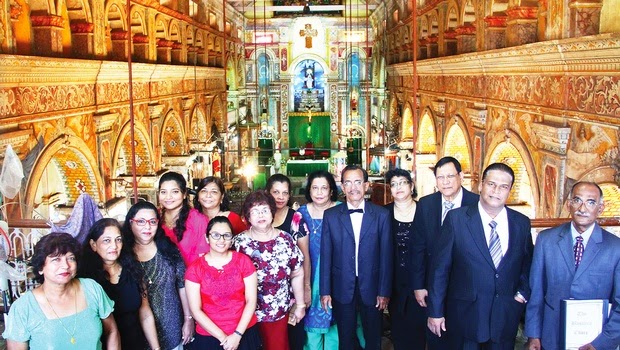COLUMN: Spouse's Turn
PT
Basheer talks about life with the actor Reena
By
Shevlin Sebastian
Photo by Ratheesh Sundaram
One
morning, in December, 1990, a girl, along with her mother, came to an
electronics shop at Fort Kochi, to get their TV repaired. The owner,
PT Basheer, agreed to do so. As he stared at the girl, Cupid struck.
“Unlike most girls, Reena had a striking look,” says Basheer.
Thereafter, he saw her many times, because Reena would drop in to
visit her uncle, an ophthalmologist by the name of Shaheer Bava, who
lived near Basheer's house. “I never spoke to her,” says Basheer.
“But I liked her.”
Soon,
fate intervened. A family friend brought Basheer a marriage proposal
for Reena. Basheer did not take long to say yes, although there is a
ten-year age difference between the two.
The
wedding took place on May 10, 1992, at Fort Kochi. And the couple did
something which is not done at a Muslim wedding. They fed each other
mouthfuls of food during lunch. “Reena had told me earlier about
her wish,” says Basheer. “And we were bold enough to do it.”
For
their honeymoon, they went to Kodaikanal. And Reena came up with an
unusual request. She told Basheer she had never been on a cycle. So
Basheer hired one, made her sit on the rod in front, and they rode
around the Kodai lake.
“Reena
was so excited about sitting on a cycle for the first time,” says
Basheer. “She was only 18, so I could understand why she was so
enthusiastic.”
Reena
is also aggressive. “She wanted to learn painting, so she did
that,” says Basheer. “Then she took classes on cooking and
ceramic works. Soon, she began giving cooking classes for foreigners.
Later, Reena ran a boutique called 'Sensations' for seven years on
the ground floor of our home. Then she got a job as an anchor for a
TV channel. Reena is always into something.”
Seven
years ago, there was a competition for mothers on a TV channel. Her
son, Binu, saw the promos and sent an application by SMS on behalf of
his mother.
So,
Reena took part. “It was a turning point for her,” says
Basheer. “[Director] Lal Jose was a celebrity guest. He saw
Reena's performance as a dancer enacting a song, 'Bhawra Bada
Naadan', from 'Sahib Bibi Aur Ghulam'. The original picturisation was
on Waheeda Rahman and Guru Dutt. Reena was dancing and showing all
sorts of mannerisms. She also did a skit where she played an actress
who pretends to have many roles, but in reality, she did not have
any.”
An
impressed Lal Jose gave Reena her first role in 'Mulla', as Biju
Menon's wife, Malathi Akka. Some of the other films she has acted in
include 'Honeybee', 'You Can Do', 'Pigman', 'Teens', 'Ormayundo Ee
Mukham', 'Ghost House', 'Traffic'
and 'Bharya Athra Pora'. And just the other day, Reena returned
from a 22-day shoot in Palakkad for a film called 'Mariyam Mukku',
which stars Fahadh Faasil and Manoj K Jayan. Reena plays Clara,
the wife of Manoj.
When
a film is released, the family, which includes son Binu, and daughter
Anjala, will go and see it on the first day. “I will tell her
frankly if I liked her role or not, and whether there is scope for
improvement,” says Basheer. “The role I liked the best was in
‘Violin’, in which Reena played an Anglo-Indian woman. Today, she
is a much more confident actor.”
And a
good mother too. “Reena is more like a friend, rather than a
mother,” says Basheer. “Often, on weekends, she will go with the
children and their friends to happening places to chill out. Reena is
able to be on the wavelength of her children very easily.”
Reena
can also get on Basheer's wavelength easily. So when she saw a photo
of a dazzling ruby set in a magazine, she was able to persuade
Basheer to buy it for her. “But Reena also buys me gifts all the
time,” says a smiling Basheer. “In fact, the last gift she gave
me was an I-Pad.”
Nevertheless,
there are negative attributes. “Reena has so many ideas that she
does not stick to one thing for long,” says Basheer. “She will
start something, it will go on for a while, then she will have a new
idea and would want to try that. Now she has started a cake shop,
'Temptations' in Fort Kochi. Reena wants change all the time. This
can be difficult to adjust to, but this is also what makes her so
interesting.”
When asked for tips for a successful marriage, Basheer says, “There should be a mutual understanding. Both spouses come from different backgrounds. So, husband and wife have different traits. It does not mean that all the traits are positive. Some can be negative, too. So you have to work hard to develop an understanding. If you have that, you will be able to overcome all the difficulties that arise in a marriage.”
(The
New Indian Express, Kochi and Thiruvananthapuram)














